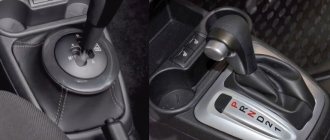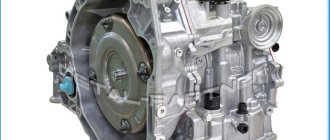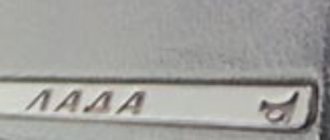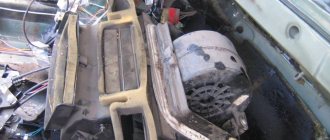The robotic gearbox is a joint development of AvtoVAZ together with the German company zf.
How does a “robot” work?
The robot is still the same 2180 gearbox with a cable drive with redesigned mounts, but in addition with an installed automatic shift mechanism, which was developed by the German company ZF. The automatic “actuator” mechanism depresses the clutch for you, puts the gear in gear, and releases the clutch.
The robot selector has the following positions:
N – neutral
R – reverse gear
M – manual switching mode
Vesta robot control diagram
In fact about the robot: Is it worth buying a car with a Robot?
If you are interested in the question of whether it is worth buying a robot, we will tell you: sign up for a TEST DRIVE, because it is free. Only by experiencing the robot’s operation yourself will you be able to understand whether it is suitable for you or not. If it doesn’t fit, then a manual transmission package is waiting for you.
AvtoVAZ says that the gearbox is suitable for everyone; AMT has 20 different switching algorithms. But this is not entirely true.
A little from myself: If you have a harsh character and you need appropriate behavior from a car, a robot is not for you. The robot is designed for calm, leisurely driving at medium speeds with smooth shifts and saving fuel and the clutch disc. And the question immediately arises of how this transmission will perform on Vesta Sport: how much the settings will be changed, whether sportiness will appear, etc.
Editorial Lada Vesta: searching for a common language with the AMT box
Moreover, the clutches close most quickly when you carefully operate the gas; when starting “to the floor,” there is again a clear pause in operation, but even in this case there are no jerks. The most unpleasant outcome is, again, when copying the “automatic” algorithms of machines with classic gas turbine engines . If you sharply press the gas at the start and then release it, there will be a pause at the start, a jerk, and an unpleasant vibration of the engine.
In general, you need to handle the gas pedal as carefully as if you had a simple “mechanics”. When the clutches overheat, for example, in the case of frequent starts in a traffic jam with a high load, they promise a tougher engagement, but I could not bring the box to this mode.
Starting uphill
But I experimentally found out that when starting up a hill in a loaded car, the automatic transmission adapts and begins to act a little more harshly: the starting speed is a little higher and the clutch is a little harder. It seems that the hard start algorithm works simultaneously with the hill start assistant, which is also present here.
On Opel's robot, the most unpleasant situation was precisely starting up a hill, especially a steep one. The car managed to roll back, and when you pressed the brake pedal, it released the clutch again, so you had to use the handbrake and inhale the smell of a scorched clutch. Vesta is practically insured against such a development of events - on a small slope the car can roll back a little when starting, but by an insignificant amount. If the brakes were pressed harder, then it is held until the clutch is activated, and the start is easy and graceful. It is not entirely clear what the algorithm for the behavior of the start-up assistance system depends on, but most likely, the car is guided by the degree of pressure on the brake pedal and by the tilt/acceleration sensors. In any case, Vesta easily starts uphill, except that a steep ramp will make the clutch “burn” a little - the starting speed will be closer to two thousand.
On acceleration
After the start, the car accelerates, and as the speed increases, the gearbox changes gears. Unlike sports drivers, the gearbox is not able to change gears without relieving traction. Or, more precisely, he doesn’t want to. The switching time, according to the VAZ, is about 1.72 seconds, which is clearly longer than the time of a good athlete.
But everything goes as smoothly as possible, without bumps or jerks. The most unpleasant pause when switching from first to second gear is a very short first and rather long second, and the drop in acceleration is quite noticeable.
At transition 2–3, the pause no longer seems so dramatic. Further shifts are even smoother and almost imperceptible. This style is typical for an experienced driver in a calm environment, when he tries to take care of the car as much as possible. However, this same style is the safest; it allows almost no jerking of traction on the wheels, which means there is less chance of slipping or simply slipping. Unlike earlier designs, there is no point in releasing the gas at the moment of switching - the car will do everything itself, there will be no impact in any case.
Downshifts can be divided into two types. Shifts with traction relief are completely mundane and uninteresting - they are simply unnoticeable. In most cases, the car brakes with the engine in fifth gear, and only when the speed drops to 1,200 does it begin to gradually reduce gears. Most drivers have been too lazy to do this for a long time, but the “robot” is tireless and continues to push lower gears as the speed decreases. This will allow you to start picking up speed without a pause. If you smoothly press the gas, the thrust will appear immediately; if you press the gas to the floor, you will have to wait a little, because the box under the thrust will wait an agonizing 1.72 seconds to switch even further “down”.
Problems with the Robot
The AMT (robot) mechanism itself is quite reliable: The box is painfully familiar to all of us, and the actuator inspires confidence. The actuator has a service life of 10 years, officially it is not repairable, but now they do everything, and repairing such an actuator is not a problem, the main thing is to lubricate it well. But there are the following “jambs” with the robot, but mainly related to the first, early models:
Long switching . As mentioned above, this is not a problem, it is a feature. Use manual mode.
Valeo clutch . As it turned out, Valeo does not match the Vesta in terms of vehicle weight, which is why current models receive a Sax clutch. Valeo quickly wore out, there was a difficult start, slippage and clutch smell were felt. The first Vesta models received the Valeo clutch.
Principle of operation
The uninitiated reader will be interested in the operating principle of this unit. At its core, the Lada Vesta variator, which will eventually be installed on the “Lux” model, is an advantageous combination of a manual transmission and an automatic transmission with the ability to both automatically change speeds and manually by manipulating a lever located in the cabin.
And yet, how does this inherently ingenious device work? The five-speed Euro gearbox from Renault is equipped with a hydraulic drive - quite leisurely, but reliable in operation and practically trouble-free. This drive acts on the engine, adjusting its speed and fuel injection intensity in accordance with the factory settings, corresponding to the required power for each specific gear (more details in the attached photos).
With manual control, the unit transmits the movement of the lever to the functioning mechanism (moving forward - upshifting, moving the lever back - downshifting), as when using a manual transmission. In the automatic version, gears are switched without driver participation - special sensors record engine speed and provoke an increase (decrease) in the gear number when it reaches a certain torque.
Advantages of "Robot"
The advantage of a robot over mechanics: convenience, because Only one leg is occupied, both hands are on the steering wheel.
The advantage of a robot over an automatic: it is more economical (What is the fuel consumption?) than a conventional automatic, you can tow a car, slipping is allowed on the roads, the dynamics of the “mechanics” are preserved.
It is also worth noting that the robot has protection against “crooked hands”. In other words, randomly switching the robot selector while driving will not cause any damage. In addition, Priora, like Vesta on a robot, can be started from a pusher, you can drag a trailer, tow a car - you just need to switch to mechanical mode.
The first robots were installed on the Lada Priora with a 1.6 liter engine producing 98 hp. But the robot has already been reprogrammed for the new 127 engine, paired with which Vesta will be produced.
Description of transmission
It became known that the robotic gearbox was tuned by specialists from Porsche; well-known presenters on YouTube are happy to report this fact. Despite the low quality of the video, we publish it because of the usefulness of the content:
To equip the luxury Lada Vesta models, the designers abandoned the VAZ robotic gearbox. However, the standard VAZ gearbox is not included in any power unit - in previous Grant, Priora and Kalina models, significant shortcomings were found that reduce the service life of the robotic gearbox. Lada Vesta will be equipped with a French-made Euro five-speed transmission, which is installed, among other things, on many of the latest Renault models.
How does this robot box differ from the standard VAZ one? Firstly, one of the most positive differences is the higher level of quality of its assembly - the components provide a more reliable clutch and faster gear shifting while driving. Driving dynamics are not lost, which becomes clear from many reviews from drivers who have tested this gearbox. Secondly, while driving, this transmission makes significantly less noise, which has a positive effect on the quality of driving (the driver gets rid of an intrusive irritant; in addition, without noise, you can talk more calmly with passengers or listen to the radio).
Specifications
| Name | Renault JH3 (JR5) | Manual transmission - 21087 |
| type of drive | Wire rope | |
| Number of speeds | 5 | |
| Main couple | 3,9 | |
| Gear ratio | 3,87 | 3,94 |
| Acceleration to “hundreds” | 11,2 | 10,2 |
| Maximum speed (km/h) | 175 | 188 |
| Fuel consumption (l/100 km) | 6,9 | 7,5 |
| Gear ratios for each gear | 3,636; 1,950; 1,357; 0,941; 0,784 | 3,727; 2,048; 1,393; 1,029; 0,795 |
Installing a shorter main pair increased the dynamics of acceleration, taking one second from the French “brand”. Adjusting the gear ratios for each gear made the transitions to higher gears smoother, without jerking, and dynamic.
Malfunctions and ways to eliminate them
| Malfunctions | Troubleshooting Methods |
| Transmission howl at 2000 – 3000 rpm | Insulation lining for gearbox control cables |
| Knock at idle | Replacing the pressure bearing |
| Critical wear of gears and teeth | Replacement with new ones, cannot be restored |
| Oil leaks from seals are less common. | Replacement of sealing seals with new ones. Overhaul of gearbox |
Lada Vesta and manual transmission: five reasons to buy for and four against
A certain part of motorists continue to ignore the achievements of transmission cybernetics and choose cars with a manual transmission. If we analyze their arguments, we can formulate five main reasons based on which it is worth considering this option:
- Affordable price - the basic model costs 509,000 rubles, for the robot you need to add 25,000 rubles. If you take a car with a manual transmission, then for the money you can get a higher level of equipment. A new AMT robot unit from a dealer costs 56,200 rubles, plus about 10,000 more for installation, so if something happens, the amount for repairs is quite impressive, which cannot be said about a manual gearbox.
- Full configurations – for models with manual transmission there is no discrimination in terms of configurations. If you want a “full stuffing” of a car, that’s not a question, and it’s not necessary to take a robot because of the additional options.
- Pleasant dynamics - according to documents, a car with a manual transmission accelerates to 100 km/h 1 second earlier than its automatic counterpart. In practice, this is significant time, which does not allow you to sweat when overtaking.
- Reliability - according to reviews and tests of the Lada Vesta, the mechanics did not give any particular cause for alarm, especially since in case of repairs the costs will be significantly lower.
- Potential liquidity - after a certain time, selling a car with a manual transmission on the secondary market will be much easier.
Opponents of the archaic manual transmission have compiled a package of arguments that should, in their opinion, force the future owner to refuse to purchase a Lada Vesta with a manual transmission:
- The behavior does not inspire confidence - the drawstring leaves a feeling of looseness and viscosity. The lever strokes could be made smaller, and the force on it could be more uniform.
- There is no fuel economy - judging by the passport, a car with a robotic transmission is somewhat more economical.
- Unjustified savings - the trim of the manual transmission lever is made of cheap, untidy plastic, the finish of the robot looks neater.
- Operational disadvantages - the robotic box requires less oil to function, so in cold weather it does not require heating.
The latest generation of Lada Vesta with mechanics and real reviews from car owners
Before the release of the latest generation, AvtoVAZ management stated that the gearboxes that were equipped with previous models did not meet the requirements of the new car. The domestic manual transmission was abandoned, and was replaced by an imported analogue - the five-speed JH3 from Renault-Nissan.
It is quite reasonable that the new Lada Vesta AMT and reviews from owners have their fans, but the current manual transmission is also not losing ground. Most car owners note that compared to the old box, the noise level is significantly lower. In addition, the advantages of JH3 include:
- More precise adjustment of switching mechanisms.
- The defect of difficult gear changes caused by oil thickening at low atmospheric temperatures has been eliminated.
- Clear shifts and reliable locking of the gearbox lever.
Almost all positive reviews of Lada Vesta mechanics are characterized by the opinion of Pavel T. from Tambov:
“If anyone drove the previous models, they will immediately feel the difference. The JH3 manual lever from Renault pleases with its moves and selectivity. Unlike the Lada 2181 gearbox, which uses a cable shift mechanism, the imported manual transmission is significantly quieter.”
Conflicting opinions are caused by the fact that the French box is maintenance-free. If in the previous design of the manual transmission the hum could be weakened by replacing the transmission lubricant, now the plant fills in lubricating fluid for the entire operating life.
Despite the warranty obligations of AvtoVAZ, experts still recommend changing the oil every 100,000 km. It is rational to combine this procedure with changing the clutch. In addition, be sure to monitor the transmission fluid level, which should not be lower than the lower edge of the filler hole. It seems that everything was done with the car enthusiast in mind, but, for example, reviews from the owner of a Lada Vesta with a manual transmission, Andrei P., contain some complaints:
“You will hardly be able to immediately engage reverse gear on a manual transmission. The car service is not able to offer anything, citing imperfections in the design... Over time, I adapted (what to do) - I first turn on third gear, and then reverse. This “imperfection” is especially noticeable in winter, when the lubricant thickens.”
Test drive by specialists
What do professionals say about the robot box in Lada Vesta? You can find many reviews of the new product on the Internet. Most note the slow response of the box during acceleration. Some call the driving style of the Lada Vesta robot a style for summer residents. Slow acceleration of the car contributes not only to fuel economy, but also to passive safety. No matter how hard you try to squeeze out maximum speed in order to overtake three or two cars, it is unlikely that you will be able to do it quickly. True, the car behaves a little more cheerfully in manual mode, in which it is more realistic to squeeze the maximum out of the 1.8-liter engine. But, if you get used to this driving style, you begin to notice the advantages: the parts are made well and do not fail for a long time. Compared to manual and automatic transmissions, AMT provides significant fuel savings.
After the driver presses on the gas and the engine picks up speed, the transmission begins to upshift. The problem is that the robot on the Vesta cannot do this without reducing the thrust. The switching time fluctuates around 2 seconds, which can be quite annoying at first. But you won’t feel any jerks, the clutch is as smooth and comfortable as possible. In the reviews of the owners of the Lada Vesta robot in 2022, you can find a comic name for this driving style - driving a Chinese dummy. Due to the excessively sharp speed difference between first and second gear, Vesta drivers and passengers nod due to uneven acceleration.
But, despite various points of view, most reviews about the Vesta 1.8 robot indicate that the introduction of an automated manual transmission was a big leap forward for the domestic manufacturer. Car enthusiasts hope that the improvements will not end there; Lada engineers will properly finalize the box, and it will be a pleasure to drive. By the way, on the official website of the automaker there is already a survey on what users would like to change in the AMT box. So you should be patient - improvements are just around the corner.
Which is better to choose manual or AMT?
The choice between a manual transmission and AMT should be made with a cool head, having calculated all the pros and cons in advance. On the Internet you can find many good reviews about the mechanics or robot of the Lada Vesta. But most drivers opt for an automated manual transmission. It is much more convenient and economical to use. But lovers of classics and conservatives still prefer the usual mechanics. You can only understand whether a car with AMT is suitable for you or not by trying it in action.











